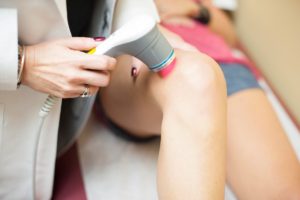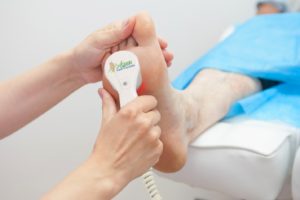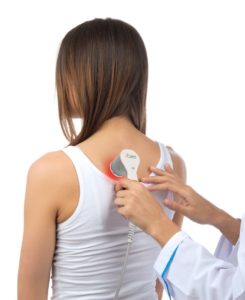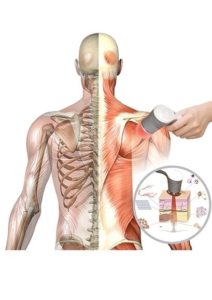Laser Therapy, also known as Low Level Laser Therapy or Cold Laser Therapy, uses light from a laser to provide drug free, non-invasive pain relief. The laser unit uses a light emitting diode to produce a focused beam of light at a specific wavelength. This laser beam is then directed at the skin above a region with pain, and different wavelengths provide different levels of penetration into the tissue. Laser therapy is pain free, only causing a warming sensation, and is completely non-invasive. It has been scientifically proven to provide pain relief for a wide variety of injuries, and everyone from professional athletes to post-operative patients can utilize it to heal faster and feel better.
The Science Behind Laser Therapy
It may seem hard to believe that something as simple as light can provide pain relief. However, looking deeper into the mechanism of action of laser therapy shows why it is so effective. In 1905, Albert Einstein developed the quantum theory of light, which states that light exists as both a wave and as particles called photons. These photons are like tiny packets of energy. In laser therapy, a concentrated beam of photons is applied to an area with inflammation and pain. Inflammation can cause nitric oxide to bind to cytochrome c oxidase (COX), a key enzyme in the mitochondria. COX normally binds to oxygen and allows your mitochondria, the powerhouse of the cell, to provide you with energy. Nitric oxide shuts this process down. When photons from laser therapy hit your mitochondria, nitric oxide is released from COX. This allows your cells to produce more energy that can be used in repairing damaged tissues. Additionally, nitric oxide causes nearby blood vessels to dilate, thus increasing blood flow to the injured tissue and speeding up healing. Releasing nitric oxide from COX also reduces levels of damaging Reactive Nitrogen Species and can boost levels of natural antioxidants.
Evidence for Laser Therapy
Many randomized, controlled scientific studies have proven laser therapy to be effective for a wide range of injuries. These studies found that laser therapy reduces pain more effectively and faster than a placebo. A review by researchers at Harvard Medical School and the University of Sydney found laser therapy to be effective in treating pain for:

- Sprains and strains
- Post-surgical pain
- Whiplash injury
- Muscular back pain
- Cervical or lumbar radiculopathy
- Tendinitis
- Osteoarthritis and rheumatoid arthritis
- Frozen shoulder
- Epicondylitis
- Carpal tunnel syndrome
- Tendinopathy
- Fibromyalgia
Laser therapy is clearly useful for treating a wide range of injuries. This is because it can work on many different kinds of tissues to reduce inflammation, promote healing, and provide pain relief.
In addition to the many scientific studies proving the efficacy of laser therapy, many athletes have utilized laser therapy to help them get back on the field. Mitch Morse, an offensive lineman for the Kansas City Chiefs, received laser therapy while playing at the University of Missouri. After spraining his big toe, he said, “Turf toe for me was the most painful of all my injuries. It’s paramount to have healthy feet and healthy toes.” With laser therapy, Morse was able to make a full recovery at Mizzou and was drafted by the Chiefs. Markus Golden, an outside linebacker for the Arizona Cardinals, had a similar experience. A hamstring sprain sidelined Golden for a few weeks, but laser therapy got him back on the field in time to become an SEC East champion.
Types of Laser Therapy

There are different classes of lasers that emit different levels of light. The original lasers used were FDA Class III lasers – the same kind that’s found in Blu-Ray players. These lasers had a power output from 200-500 milliwatts. The newest and most effective lasers are Class IV lasers. This is the kind of laser we use for laser therapy at the Orthopedic and Shoulder Center. We want to give you the best treatment possible for the most pain relief, so we use cutting edge treatments. Our laser is an Aspen 30 watt dual-wavelength laser, which is 60 times more powerful than the older kinds of lasers. Whereas most laser units utilize only one wavelength, our laser can use two wavelengths that penetrate to different depths. Different injuries require different levels of penetration, and our dual-wavelength laser provides the most targeted treatment possible.
If you are suffering from muscle or joint pain, are recovering from a surgery, or have an injury that just won’t go away, you deserve the latest in innovative medical treatment. Laser therapy could be right for you. Dr. Lawrence Li and the staff at Orthopedic and Shoulder Center know how to utilize laser therapy to get you back to what matters.


